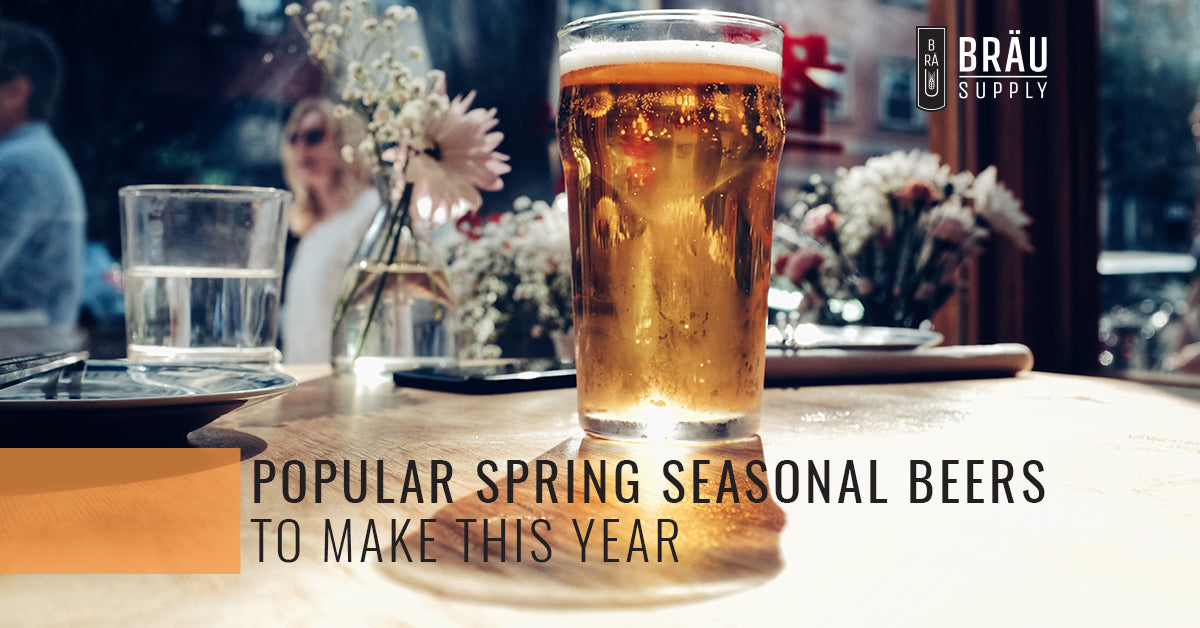Designed in Canada. built for serious brewers.

Popular Spring Seasonal Beers To Make This Year
April 11, 2018 4 min read

Ah yes, the sights and sounds of spring are all around us. Birds are chirping, bees are buzzing, and UniBräu electric brewing systems are clicking on to fill pint glasses with delicious, homebrewed beer. Spring is a season for change and renewal, so this year, be a little daring in what you’re brewing, and take a look at these popular styles that are filling many homebrew systems this spring.
What Makes It A Spring Seasonal?
Spring is a time for transition. We see the first notes of summer, but we are still dusting off the last traces of snow in some places. Our spring beers represent these transitions too. Spring beers can appeal to dark and light beer drinkers. Some of our favorite spring beers toe the line between the two. Typically, we start to see more hops being added to spring beers than in winter, but not quite to the level of some of the double IPAs we see in summer. Here are some styles you might consider brewing this spring.
Bocks
If you’re ready for the easy-drinking lagers of summer, but can’t quite let go of the darker, roasted notes of a winter porter, then a bock might be the perfect style for you. For springtime, we’re fans of a good Maibock, which is the lightest of the Bock styles. This beer has a nice hop note but still has that wonderful maltiness of a good German style beer. We’ve found luck using lighter malts, like Pilsner and Munich malt, and even using some light British malts. This lends the beer a malty character without being too sweet. To get a clear, crisp hoppy note, we like traditional German Hallertau hops. These hops have a lightly flowery and spicy aroma. For something a little different, try using some Sterling hops toward the end of your boil for a pleasant citrusy twist to your beer. Use a lager yeast to get the best results.
Saisons
Few beers capture the tastes of spring better than a saison. These Belgian-style beers are fermented with wild yeast and have a “funky” character that pairs well with a stroll through a blossoming garden. Typically on the sour side of beers and lower in alcohol, we think a saison is a great way to transition into summer time. To start your saison, you’ll want to use grains on the lighter end of the Lovibond scale. Consider using some pilsner and wheat malts to give it body, and add just a little bit of a darker, chocolate malt to add some color. For that classic spicy, citrusy hop taste, you might consider a hop like the Northern Brewer, which has a minty character to it. To give your saison a spicier edge, a bittering hop, like Opal, is probably the way to go. Naturally, you’ll want a Belgian yeast strain, and many saison yeasts are readily available.
Pale Ales
Pale ales are a great spring beer to brew at home. Spring signals the start of the new hop season, and you can take advantage of the first and freshest hops of the season by brewing a tasty pale ale. A crisp, clear, and citrusy pale ale is a welcome treat after a long winter of heavy imperial stouts. These beers can also be great test beds for hop varieties you might like to use in your summer IPAs.
For a pale ale that will slake your thirst on a warm spring afternoon, start with a variety of malts that will leave your beer looking clean and clear. Pale, ESB, Crystal, and Munich malts are ideal for a pale ale.
From there, you can get creative with the types of hops you’re using, and when you’re using them. For a great bittering hop, throw some fresh Cascade early on in the boil. Toward the end of the boil, use hops, like Fuggles, Glacier, and Centennial, for a hop-forward note. You might even try dry hopping your beer after the boil using First Gold and Willamette hops. For just a hint of citrus, we suggest adding dried orange and lemon peel at various points throughout the boil and with your dry hops. The result is a beer that should be golden orange in color, and hoppy and bright in taste.
Whatever beer you decide to brew this spring, make sure to share it with friends to welcome the return of sunny days and summer rains. Of course, to make the most of any brew, we recommend it's brewed on one of the fantastic brew systems from Bräu Supply!
More articles how to brew beer
The ultimate guide to Kveik yeast: Unleashing it's fermentation potential
Revolutionizing home brewing: The simplified art of no sparge brewing
Exploring amber ales: A guide with a twist on the traditional recipe
Mastering cold crashing: Enhancing beer clarity and accelerating the aging process
What is the basic function of the fermenter?
What causes a fermenter to heat up?
The art of lagering: A guide to perfecting the cold conditioning process
Troubleshooting fermentation problems in brewing: A comprehensive guide
Subscribe
Sign up to get the latest on sales, new releases and more …


